Red Springs
Project Overview
Click here for Red Springs Project Update (May 1, 2020)
Located in Northwest British Columbia (Figure 1), the Red Springs Project involves a system of three or more copper/gold porphyries. This system has two distinct mineralized zones: an extensive thrust fault-hosted high-grade gold-bearing tourmaline breccia mineralized zone with cobalt, copper, antimony and bismuth credits; and a second zone with high-grade antimony-silver mineralization. The tourmaline breccia gold-cobalt mineralization represents the first of its type discovered in British Columbia.
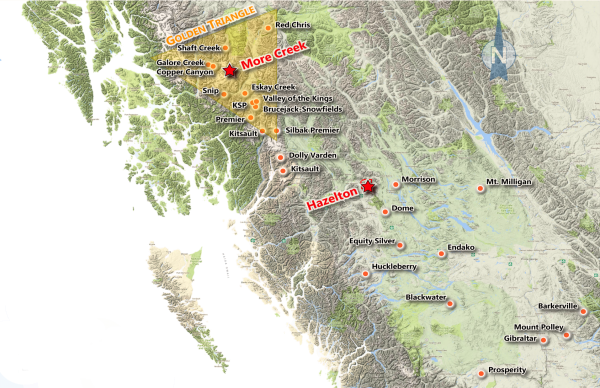
Figure 1, Location Map of Red Springs Project and More Creek Project
Tourmaline breccia pipes/zones are common in porphyry camps globally and are associated with world-class deposits (Chile - Los Sulfatos, Sur-Sur, Donoso). They can occur in clusters and vertical continuity can run >2 km deep (Figure 2, 3). Most known tourmaline breccias occur with a vertical orientation in the shape of pipes but they can also occur with horizontal orientations when fault zones provide a conduit for the thermal solution produced by the porphyry system.
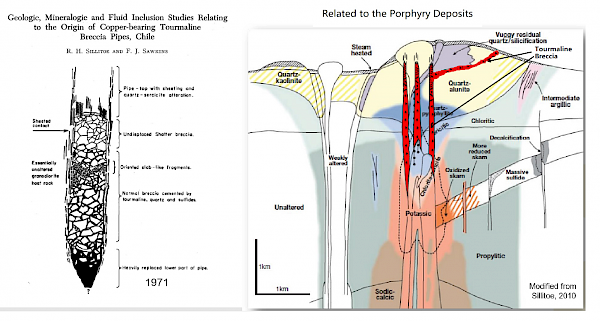
Figure 2, Geology of Tourmaline Breccia Pipes/Zones and Relation to the Porphyry Deposits (Modified from Chakana Copper Corp, 2018)
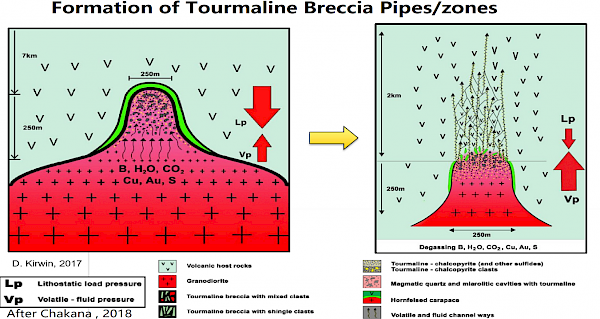
Figure 3, Formation of Tourmaline Breccia Pipes/Zones (Chakana Copper Corp, 2018)
The Red Springs Project is defined as a tourmaline breccia complex superimposed on a large porphyry copper system which includes a low angle thrust fault-bounded sill-like tourmaline breccia mineralization zone with multiple associated copper porphyry targets. The gold-cobalt mineralization is a sedimentary rock-hosted, multiple phases porphyry intrusive related thermal solution overprinted tourmaline breccia with strong silicification and sulphide alteration. It includes an approximately 1 km2 tourmaline breccia mineralization zone and three porphyry copper targets (Figure 4, 5) discovered during the 2018 exploration season. The Red Springs tourmaline breccia complex has a horizontal sill-like orientation in a thrust fault zone.
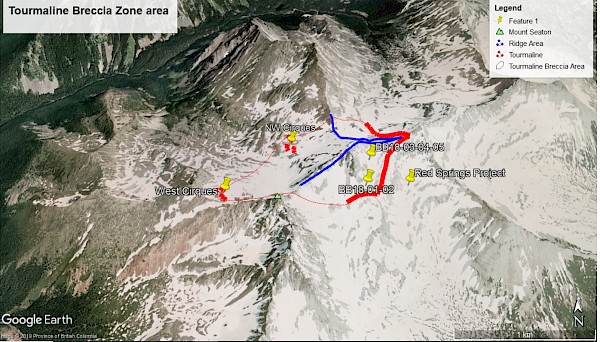
Figure 4, Tourmaline Breccia Zone/Vein Area at Red Springs Project
Gold-bearing tourmaline breccia zones and veins (Figure 4) have been found in the Backbone, North Cirque and Northwest Cirque areas at Red Springs. The Backbone area, which was the focus of the 2018 exploration season, is a low dip angle thrust fault-hosted sill-like large tourmaline breccia mineralization zone. This zone has a strike length of 1000 m and is approximately 15 m wide at the surface outcrop; (Figure 6) and may extend to the west and north west for at least 1 km. Mineral grades from surface grab and chip samples can be up to 40 g/t for gold, 0.36% for cobalt, 1% for copper and 1% for bismuth respectively (Table 1). Mineral grades from surface channel samples can be up to 25.86 g/t for gold, 0.06% for cobalt, 0.48% for copper and 0.5% for bismuth respectively (Table 2 below). The 2018 drilling program (Figure 7-9) confirmed the strike continuity from drill pad A to drill pad B, along 300 m with a dip extension of approximately 100 m headed west to the surface channels at Backbone. The Backbone tourmaline breccia mineralization zone is much thicker in the drill holes than the surface outcrops. The zone in drill hole BB18-03 is 26 m thick and displays well developed gold, cobalt, copper and bismuth mineralization features with grades up to 6.60%, 0.1%, 0.22% and 0.04% respectively (Table 3).
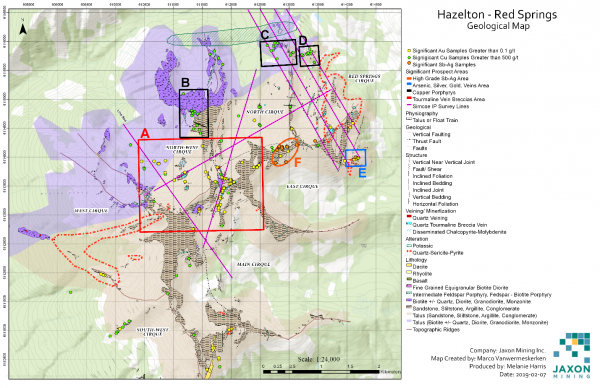
Figure 5, Tourmaline Breccia Mineralization and Three Copper Porphyry Targets at the Red Springs Project
Based on the surface mapping, IP survey and drilling program completed in 2018, an extensive area of up to 1 km2 of tourmaline breccia mineralization has been defined (Figure 4) extending from the Backbone to the North Cirque and Northwest Cirque areas.
Highlights
- 41,512 hectares
- 2017/2018 discovery – 1000 m strike high grade gold-cobalt tourmaline breccia mineralization zone with cobalt, copper and bismuth credits
- 5 holes – 1057 m of diamond drilling, assay results from drilling samples returned up to 8.2 g/t AuEq with 6.6 g/t Au, 0.1% Co and 0.04% Bi (Table 3)
- BB18-03-05 confirms 20-26 m tourmaline breccia intercept width with 100 m dip extension from surface with gold equivalent grades from 0.53 to 1.44 g/t at down hole depth of 64-90 m
- 40 m strike extension, 2-3 m thick high-grade mineralization band near the hanging wall of the thrust fault with gold equivalent grades from 2.14 g/t to 5.00 g/t at down hole depth of 64-67 m (Figure 9);
- 16 first priority out of a total of 32 IP and magnetic anomalies (Table 4)
- 2018 discovery of high-grade antimony-silver mineralization zone
Tourmaline is widely considered as a guiding mineral for porphyry deposits and has been found in most large porphyry deposits globally. Jaxon has confirmed tourmaline mineral is associated with the three copper porphyry targets at Red Springs. The tourmaline breccia zones and veins manifest as both near vertical planar structures and as apparent strata-bound bodies. The high sulphide content results in strong oxidation, making the mineralization highly visible as brown, rusty outcrops. The tourmaline breccias are characterized by the chemical association of gold-tellurium-cobalt-bismuth-arsenic-antimony-boron and are of porphyritic intrusive origin.
Jaxon intends to undertake further geological and alteration mapping in the 2019 field season based on its conceptual geological model. The program will include further geochemical sampling, geophysics and, when warranted, a 2000 m (+/-) drilling program along the strike and dip of the tourmaline breccia zone.
2019 Work Plan (Under Development)
- Detailed surface geological mapping focused on structures and alterations
- 12 km (4 lines) IP survey to identify the source of the tourmaline breccia zone and to develop structural controls
- Five to ten 2000 m (+/-) diamond drill holes to test a number of IP anomalies including N Cirque and NW Cirque
- test the 1 km2 tourmaline breccia zone and the antimony-silver zones based on IP and surface rock sampling data
- test the three copper porphyry targets
Table 1 Significant Assay Results from N and NW Cirques Targets 1 | ||||||
|---|---|---|---|---|---|---|
Sample ID | Target Area | Sample Type | Au (g/t) | Cu (%) | Co (ppm) | Bi (ppm) |
A0020661 | North Cirque | Float | 40.41 | 6.77 | 154 | 12900 |
A0020152 | North Cirque | Grab | 31.81 | 8.33 | 2325.4 | 4869.02 |
A0020147 | North Cirque | Grab | 10.384 | 0.13 | 3631.4 | 396.55 |
A0020150 | North Cirque | Composite Grab | 6.773 | 0.18 | 1671.1 | 353.55 |
A0020148 | North Cirque | Grab | 3.337 | 0.25 | 2135.4 | 346.57 |
A0020063 | North-West Cirque | Float | 2.18 | 0.05 | 1536.1 | 361.17 |
A0020053 | North-West Cirque | Grab | 1.817 | 0.24 | 360.8 | 33.09 |
A0020113 | North-West Cirque | Select Grab | 1.628 | 0.43 | 279.2 | 509.57 |
A0020674 | North-West Cirque | Grab | 1.558 | 0.01 | 236 | 45.05 |
A0020293 | North cirque | Grab | 1.486 | 0.16 | 47.2 | 750.62 |
A0020153 | North Cirque | Grab | 1.368 | 0.02 | 99.6 | 25.1 |
A0020057 | North-West Cirque | Float | 1.069 | 0.15 | 555.4 | 75.48 |
A0020146 | North Cirque | Composite Grab | 0.881 | 0.07 | 951.2 | 100.37 |
A0020149 | North Cirque | Chip | 0.817 | 0.06 | 276.9 | 183.3 |
A0020062 | North-West Cirque | Float | 0.512 | 0.01 | 862.3 | 33.03 |
A0020341 | North Cirque | Chip | 0.411 | 0.04 | 19.7 | 651.19 |
A0020056 | North-West Cirque | Float | 0.401 | 0.29 | 273.9 | 1.6 |
A0020656 | North Cirque | Grab | 0.392 | 0.17 | 609.9 | 30.53 |
A0020657 | North Cirque | Grab | 0.345 | 0.05 | 511.8 | 12.26 |
A0020008 | North-West Cirque | Grab | 0.256 | 0.01 | 3.3 | 2.76 |
A0020665 | North Cirque | Float | 0.24 | 0.17 | 25.7 | 7.63 |
A0020009 | North-West Cirque | Grab | 0.179 | 0.03 | 26 | 5.19 |
A0020060 | North-West Cirque | Grab | 0.153 | 0.01 | 59.8 | 24.64 |
A0020145 | North Cirque | Chip | 0.135 | 0.01 | 5.1 | 26.99 |
A0020669 | North Cirque | Float | 0.124 | 1.00 | 164.3 | 134.92 |
A0020348 | North Cirque | Chip | 0.121 | 0.01 | 2.1 | 0.51 |
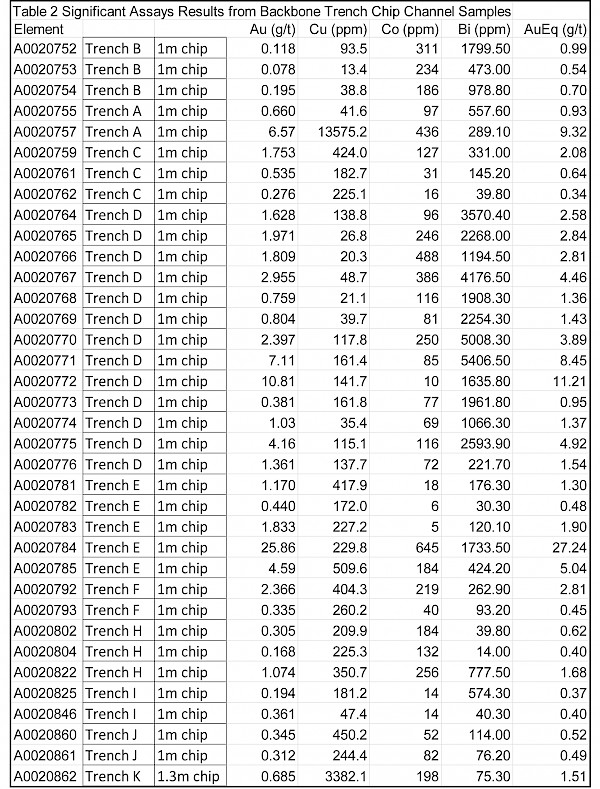
1 EqAu is calculated using long term prices for gold at $1250 USD per ounce, cobalt at $60K USD per tonne, copper at $6K USD per tonne and bismuth at $10K USD per tonne.
Table 3 Significant Assay Results from 2018 Drilling Program1 | |||||||||
|---|---|---|---|---|---|---|---|---|---|
Hole_ID | From_M | To_M | Interval | Comments | Au | Co | Cu | Bi | EqAu |
BB18-01 | 24 | 25 | 1 | 0.201 | 199 | 86.1 | 14 | 0.52 | |
BB18-01 | 25 | 27 | 2 | core loss | 0.475 | 44 | 21.6 | 29.3 | 0.55 |
BB18-01 | 38 | 39 | 1 | 1.277 | 52 | 10 | 134.5 | 1.39 | |
BB18-01 | 48 | 49 | 1 | 0.527 | 51 | 9.3 | 116.7 | 0.63 | |
BB18-02 | 22 | 23 | 1 | 0.556 | 394 | 24.1 | 39.8 | 1.16 | |
BB18-02 | 24 | 25 | 1 | 0.117 | 71 | 358.4 | 15.9 | 0.28 | |
BB18-03 | 42 | 43 | 1 | 0.175 | 23 | 2103.3 | 8.5 | 0.53 | |
BB18-03 | 67 | 68 | 1 | 4.343 | 198 | 2226.2 | 129.2 | 5.00 | |
BB18-03 | 69 | 70 | 1 | 2.427 | 251 | 627.4 | 182.4 | 2.94 | |
BB18-03 | 70 | 71 | 1 | 0.593 | 125 | 100.1 | 56.9 | 0.81 | |
BB18-03 | 75 | 76 | 1 | 1.945 | 144 | 1266.4 | 82.9 | 2.37 | |
BB18-03 | 80 | 81 | 1 | 1.498 | 370 | 6.9 | 66 | 2.07 | |
BB18-03 | 81 | 82 | 1 | 0.679 | 255 | 7.7 | 30.9 | 1.07 | |
BB18-03 | 82 | 83 | 1 | 1.866 | 956 | 8.6 | 64.6 | 3.32 | |
BB18-03 | 83 | 84 | 1 | 0.234 | 135 | 13 | 34.9 | 0.45 | |
BB18-03 | 84 | 85 | 1 | 0.607 | 321 | 11.5 | 174.7 | 1.13 | |
BB18-03 | 85 | 86 | 1 | 1.191 | 224 | 15.6 | 35.4 | 1.54 | |
BB18-03 | 86 | 87 | 1 | 0.221 | 106 | 18.7 | 13.4 | 0.39 | |
BB18-03 | 87 | 88 | 1 | core loss | 0.149 | 140 | 14.2 | 10.1 | 0.36 |
BB18-03 | 88 | 89 | 1 | 6.601 | 1000 | 16.3 | 421.1 | 8.20 | |
BB18-03 | 89 | 90 | 1 | 0.655 | 179 | 47.3 | 54.9 | 0.94 | |
BB18-03 | 90 | 92 | 2 | core loss | 1.784 | 512 | 41.8 | 60.4 | 2.57 |
BB18-03 | 92 | 93 | 1 | 0.36 | 208 | 39.6 | 19.8 | 0.68 | |
BB18-04 | 64 | 65 | 1 | 1.729 | 213 | 554.6 | 57.1 | 2.14 | |
BB18-04 | 71 | 72 | 1 | 3.593 | 198 | 5.2 | 244.2 | 3.94 | |
BB18-04 | 72 | 73 | 1 | 0.105 | 50 | 3.8 | 7.3 | 0.18 | |
BB18-04 | 79 | 80 | 1 | 0.212 | 64 | 10.1 | 8.8 | 0.31 | |
BB18-04 | 82 | 83 | 1 | 1.686 | 138 | 20.3 | 46.9 | 1.91 | |
BB18-04 | 83 | 84 | 1 | 1.039 | 154 | 113.9 | 39.6 | 1.30 | |
BB18-04 | 90.9 | 91.5 | 0.6 | vein and wallrock | 0.52 | 166 | 8.5 | 30.3 | 0.78 |
BB18-04 | 111.8 | 113 | 1.2 | 0.209 | 149 | 6.9 | 194.9 | 0.48 | |
BB18-04 | 113 | 114 | 1 | 0.324 | 32 | 9.9 | 240.5 | 0.43 | |
BB18-04 | 114.9 | 117 | 2.1 | severe core loss | 0.202 | 33 | 36.4 | 270.7 | 0.32 |
BB18-05 | 66 | 67 | 1 | 3.168 | 542 | 5471.9 | 376 | 4.88 | |
BB18-05 | 67 | 68 | 1 | 2.08 | 186 | 101.4 | 122.8 | 2.40 | |
BB18-05 | 80 | 81 | 1 | 1.406 | 82 | 1436.7 | 26.9 | 1.75 | |
BB18-05 | 82 | 83 | 1 | 0.605 | 8 | 75.9 | 0.5 | 0.63 | |
BB18-05 | 85 | 87 | 2 | core loss | 0.488 | 149 | 3.3 | 33.5 | 0.72 |
1 EqAu is calculated using long term prices for gold at $1250 USD per ounce, cobalt at $60K USD per tonne, copper at $6K USD per tonne and bismuth at $10K USD per tonne.
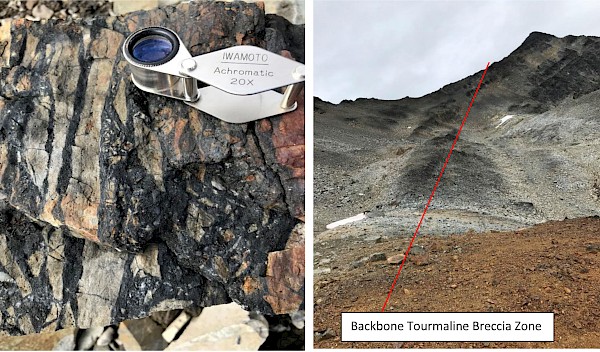
Figure 6, Tourmaline Breccia and Backbone Tourmaline Breccia Zone Outcrop
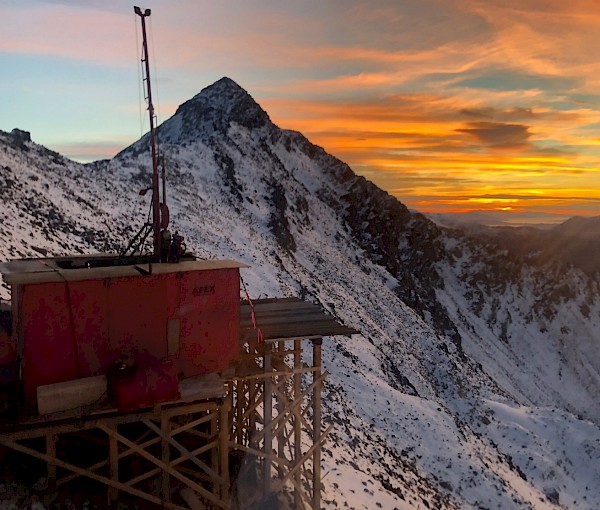
Figure 7, Holes 3-5 Drill Pad from 2018 Drilling Program

Figure 8, Sulfide Minerals (Arsenopyrite, Pyrrhotite, Pyrite and Chalcopyrite from Left to Right) in Backbone Tourmaline Breccia Drill Core
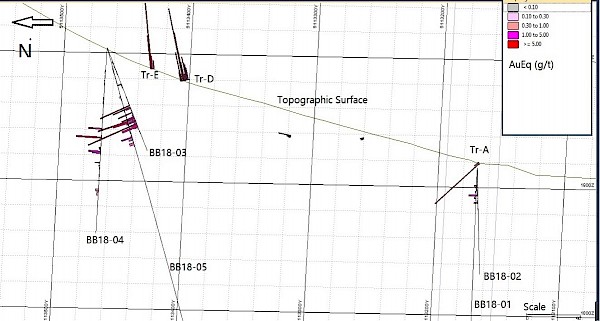
Figure 9, Drill Hole Cross Section Map of 2018 Drilling Program
Three Porphyry Copper Targets at Red Springs Project
2018 surface geology mapping, sampling and IP program defined three porphyry copper targets at Red Springs: Primary Ridge, Red Springs and Razorback copper porphyry targets (Figure 5).
Highlights
- Large and strong argillic and phyllic alteration area (Figure 10)
- Surface outcrop samples show strong chalcopyrite, pyrite, malchocite and potassium alteration with up to 1.12% copper grade (Figure 11)
- Well-developed tourmaline alteration and breccia – a guiding mineral for porphyry copper deposit
- Very strong IP and magnetic anomalies
2019 Work Plan for Porphyry Targets (Under Development)
- Detailed surface geological mapping focused on structures and alterations
- 20 x 50 m grid soil sampling program at Primary Ridge target area
- Three to five 1000m (+/-) diamond drill holes to test IP and soil geochemistry anomalies
- Seeking JV partner
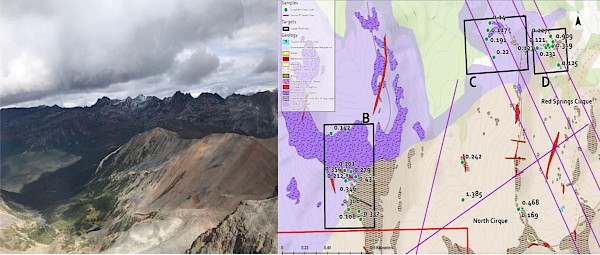
Figure 10, Left, Large argillic and Phyllic Alteration at Primary Ridge Target. Right, Geology Map of Red Springs Porphyry Targets Area with Copper Grades from Surface Grab Samples
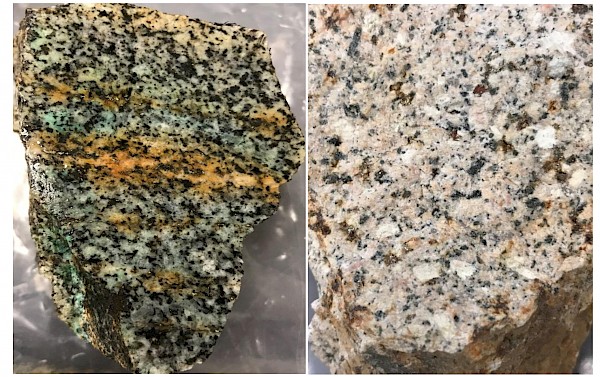
Figure 11, Left, Chalcopyrite and Potassium Alteration Veins and Malachite Alteration in Biotite Diorite. Right, Whole Rock Potassium, Pyrite Alterations in Granite
